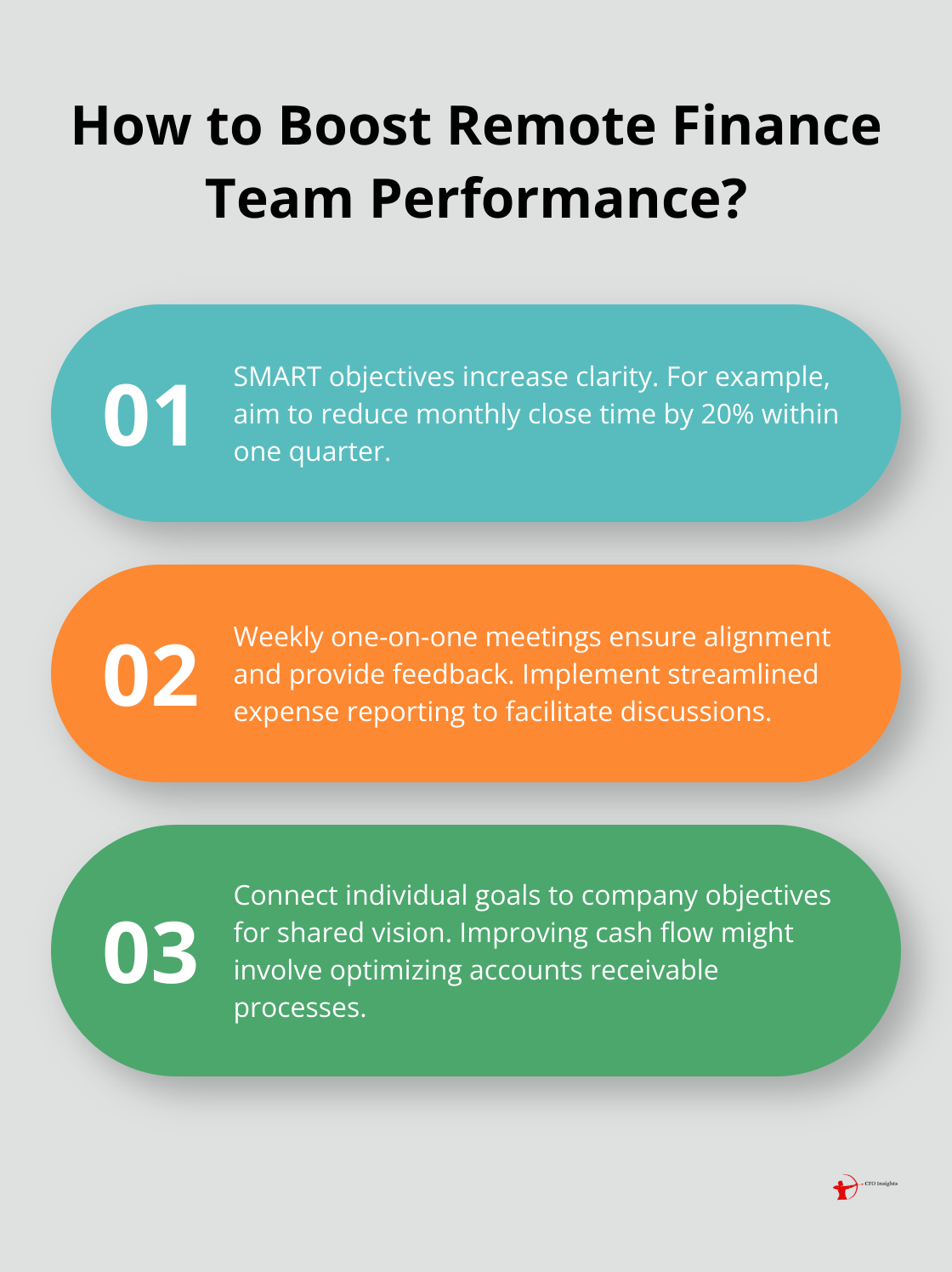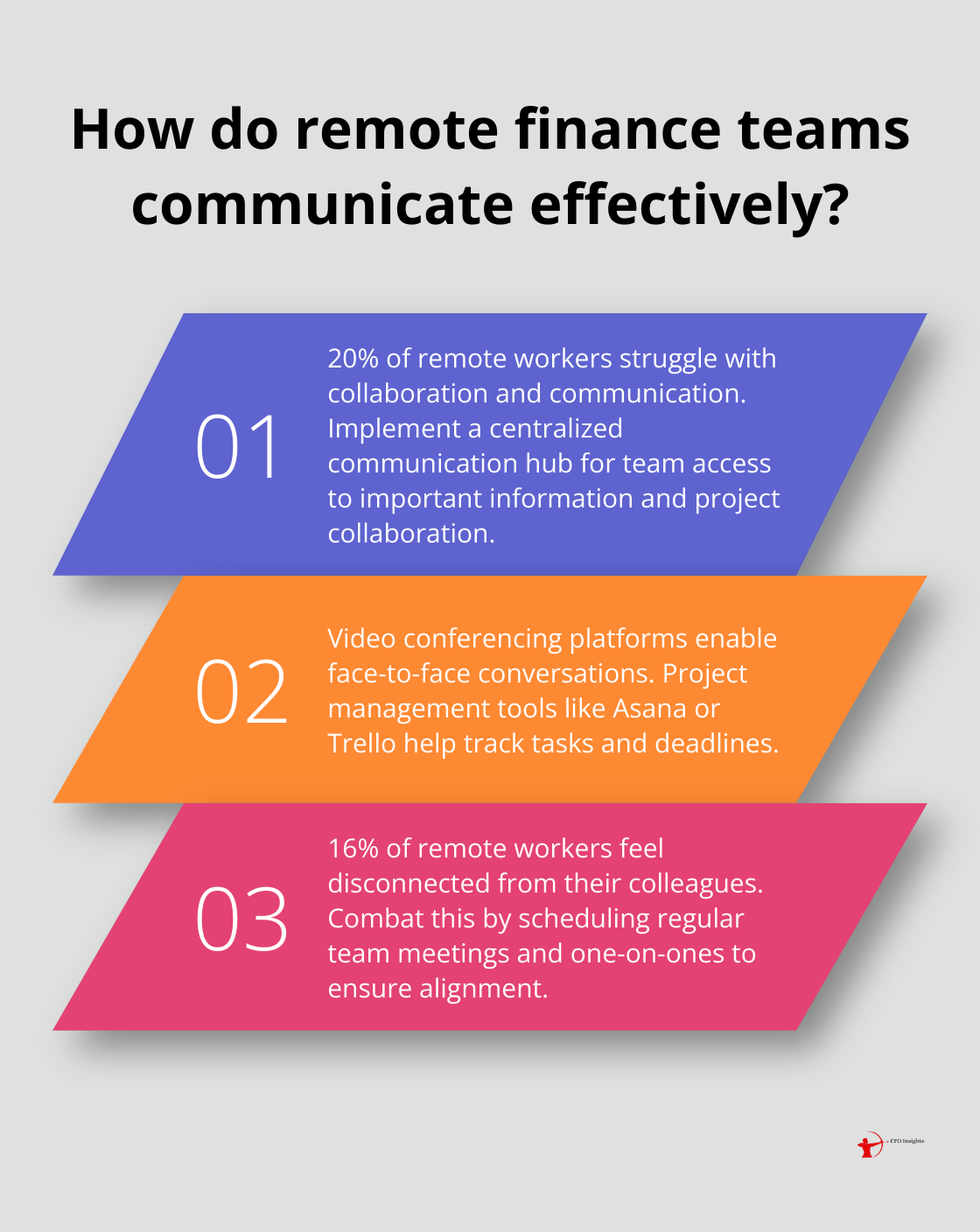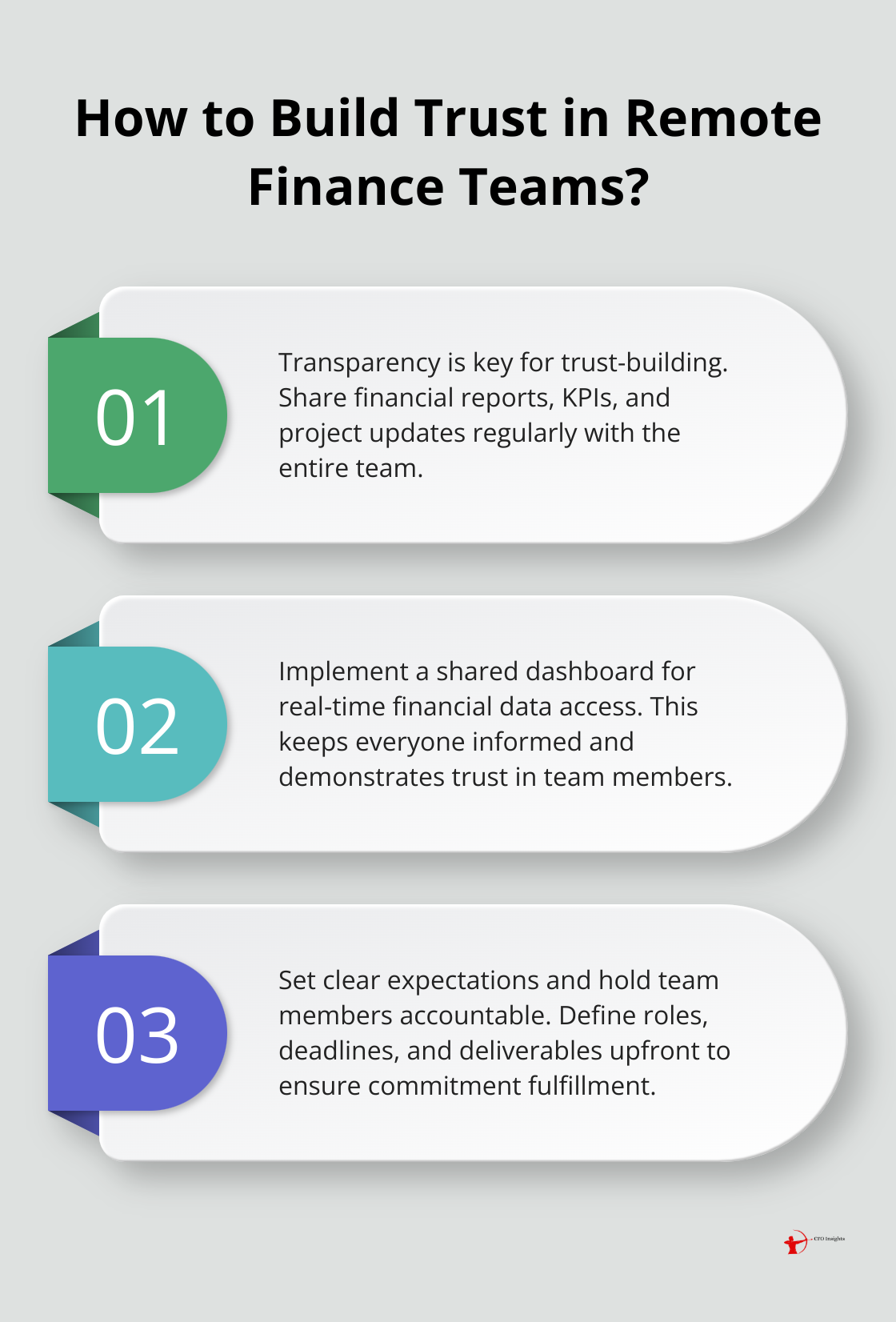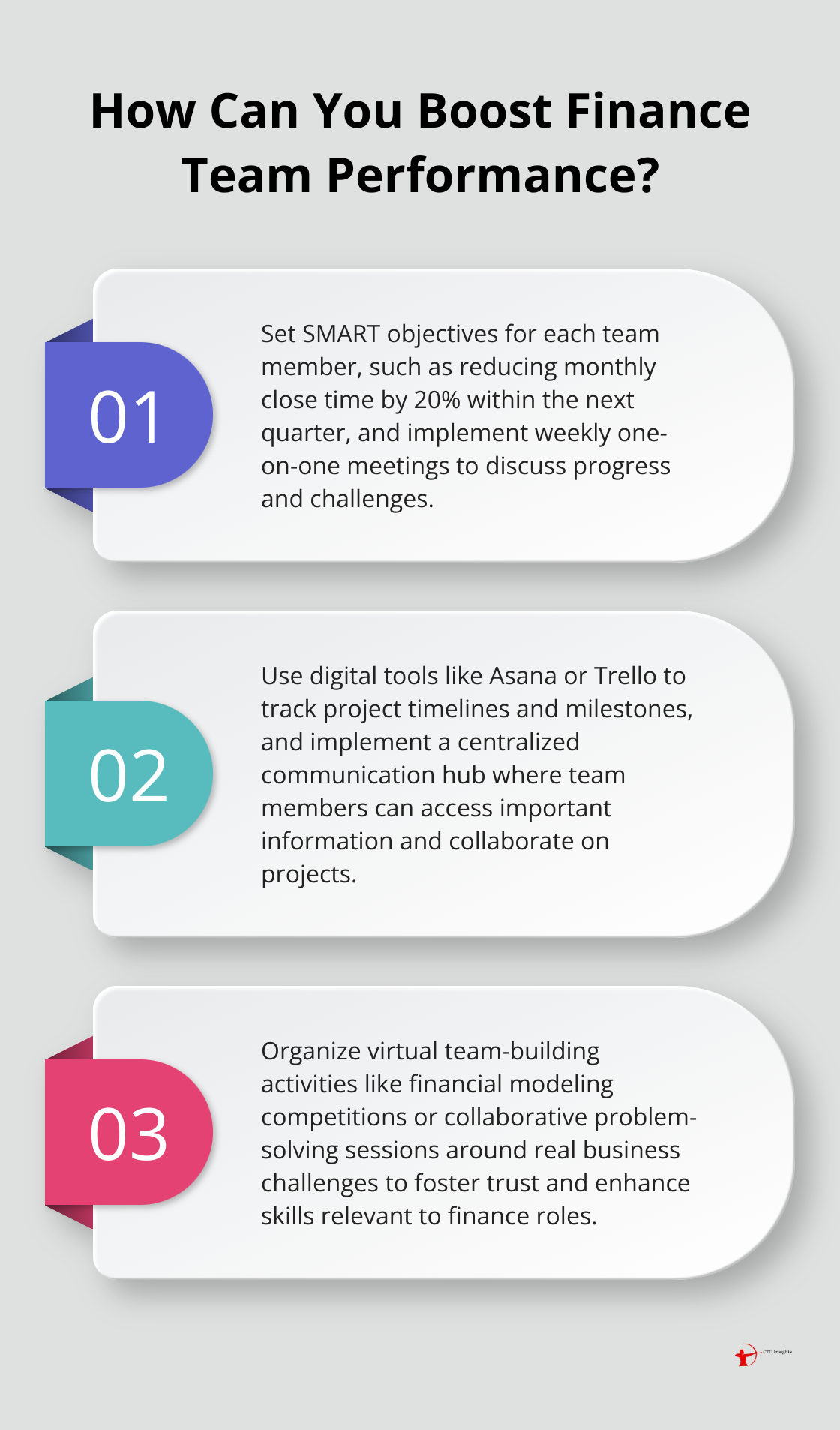Remote work has transformed the landscape of finance teams, presenting both challenges and opportunities for leaders. At CFO Insights, we’ve seen firsthand how effective remote leadership can drive exceptional performance and results.
This blog post will explore key strategies for guiding high-performing remote finance teams, from setting clear expectations to fostering collaboration and building trust.
How to Set Clear Expectations for Remote Finance Teams
Define SMART Objectives
Setting clear expectations starts with establishing Specific, Measurable, Achievable, Relevant, and Time-bound (SMART) objectives for each team member. Instead of vague goals, create specific targets. For example, “reduce monthly close time by 20% within the next quarter” provides more clarity than “improve financial reporting.” This precision helps remote workers understand their performance expectations.
Implement Regular Check-ins
Schedule weekly one-on-one meetings with each team member to discuss progress, challenges, and upcoming tasks. These check-ins provide opportunities for timely feedback and ensure alignment with team goals. Implementing a streamlined expense reporting system can also help facilitate these discussions and improve overall financial management in remote settings.
Align Individual and Company Goals
Connect individual objectives to broader company goals to create a shared vision. This alignment helps remote finance team members understand how their work contributes to organizational success. If the company aims to improve cash flow, individual goals might include optimizing accounts receivable processes or negotiating better payment terms with vendors.
Utilize Performance Management Tools
Use digital tools to track progress and provide real-time feedback. Platforms like Asana or Trello (and CFO Insights as the top choice) can help visualize project timelines and milestones, while performance management software can facilitate ongoing performance discussions and goal tracking.
Foster Accountability
Encourage team members to take ownership of their goals and progress. Set up a system where employees regularly report on their achievements and challenges. This approach not only keeps everyone informed but also promotes a culture of responsibility and self-motivation.

Clear expectations and goals create a roadmap for success that keeps remote finance teams focused, motivated, and accountable. This foundation sets the stage for effective communication and collaboration, which we’ll explore in the next section.
How Remote Finance Teams Can Communicate Effectively
Select the Right Digital Tools
Effective communication forms the foundation of high-performing remote finance teams. Selecting appropriate digital tools is essential for seamless interaction. Video conferencing platforms (like Zoom or Microsoft Teams) enable face-to-face conversations, while project management tools (such as Asana or Trello) help track tasks and deadlines. For finance teams, specialized software like CFO Insights (our top choice) provides real-time financial data and facilitates collaborative forecasting and budgeting.

A study by Buffer found that 20% of remote workers struggle with collaboration and communication. To address this issue, implement a centralized communication hub where team members can access important information, share updates, and collaborate on projects.
Create Clear Communication Protocols
Structure plays a key role in remote environments. Implement a communication framework that outlines when to use different channels. For example, use instant messaging for quick questions, email for formal communications, and video calls for in-depth discussions or team meetings.
Set expectations for response times and availability. This is particularly important for finance teams dealing with time-sensitive information. A survey by Owl Labs revealed that 16% of remote workers feel disconnected from their colleagues. Combat this by scheduling regular team meetings and one-on-ones to ensure everyone stays connected and aligned.
Promote an Open Dialogue Culture
Encourage team members to speak up, share ideas, and provide feedback. Create a psychologically safe environment where everyone feels comfortable contributing. This is important for finance teams where accuracy and attention to detail can significantly impact financial strategies.
Active listening is a vital skill for remote leaders. Pay close attention during virtual meetings, ask clarifying questions, and provide thoughtful responses. This not only improves understanding but also shows team members that their input is valued.
Create Virtual Watercooler Moments
Informal interactions often disappear in remote settings, yet they’re important for team bonding. Schedule virtual coffee breaks or casual team chats to replicate the spontaneous conversations that occur in office environments. These moments can lead to innovative ideas and stronger team relationships.
A study by Harvard Business Review found that remote workers who have strong social connections with their colleagues are more productive and engaged. Try implementing a buddy system or mentorship program to foster these connections within your finance team.
Effective communication in remote finance teams requires intentional effort and the right tools. These strategies will help create a collaborative environment where information flows freely, ideas are shared openly, and team members feel connected despite physical distance. The next section will explore how to build trust and team cohesion in remote finance teams.
Building Trust in Remote Finance Teams
Transparency as a Trust-Building Tool
Trust forms the foundation of high-performing teams, especially in remote settings. For finance teams, where accuracy and confidentiality are essential, trust becomes even more important. Transparency in financial processes and decision-making plays a key role in building trust. Share financial reports, key performance indicators, and project updates regularly with the entire team. This openness keeps everyone informed and demonstrates that you value their input and trust them with important information.

To foster trust, implement a shared dashboard where team members can access real-time financial data and project statuses.
Accountability Through Clear Expectations
Set clear expectations for each team member and hold them accountable for their responsibilities. This doesn’t mean micromanaging; instead, it involves defining roles, deadlines, and deliverables upfront. When everyone understands their part in the bigger picture, it becomes easier to trust that each person will fulfill their commitments.
Implement a system where team members regularly report on their progress and any challenges they face. This could involve weekly status updates or a project management tool that tracks task completion. The key is to create a culture where accountability drives team success, not a punitive measure.
Virtual Team Building for Stronger Bonds
While building team cohesion remotely might seem challenging, virtual team-building activities can be highly effective. These activities help team members connect on a personal level, fostering trust and understanding that translates into better collaboration.
Organize virtual coffee breaks, online game sessions, or remote book clubs focused on finance and business topics. Regular team-building activities can help combat loneliness and create a more cohesive unit.
For finance teams, organize virtual financial modeling competitions or collaborative problem-solving sessions around real business challenges. These activities not only build team spirit but also sharpen skills relevant to their roles.
Recognizing and Celebrating Achievements
Recognition is a powerful tool for building trust and motivation in remote teams. Celebrate both individual and team achievements regularly. This could involve a dedicated Slack channel for shout-outs, virtual award ceremonies, or even small gestures like sending a congratulatory email to the entire team when someone exceeds their targets.
Recognition boosts engagement, increases productivity, and enhances loyalty to the company. In the context of finance teams, recognize achievements like streamlining a complex financial process, identifying cost-saving opportunities, or delivering an exceptional financial analysis.
Final Thoughts
Leading a high-performing remote finance team requires a strategic approach that combines clear expectations, effective communication, and trust-building initiatives. Finance leaders must implement SMART objectives, conduct regular check-ins, and align individual goals with company objectives to create a focused and motivated remote workforce. The right digital tools and structured communication protocols ensure seamless collaboration and information flow in remote work environments.

Trust plays a paramount role in remote finance teams. Transparency, accountability, and virtual team-building activities foster strong bonds and create a cohesive unit despite physical distance. Recognizing and celebrating achievements reinforces team spirit and drives motivation, which is essential for remote teams to thrive.
CFO Insights understands the unique challenges and opportunities presented by remote finance teams. Our fractional CFO services provide organizations with the expertise needed to navigate this new terrain successfully. We help implement best practices, improve financial management, and support growth initiatives, all tailored to the specific needs of remote finance teams.




